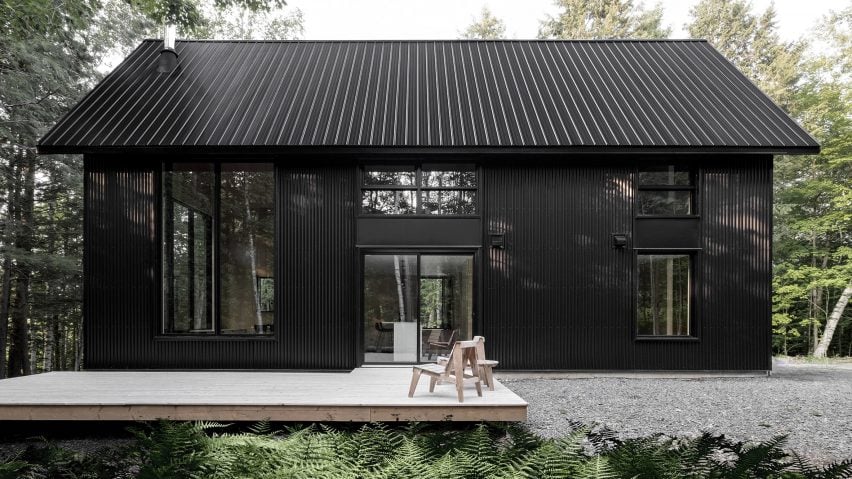Deep in the woods of Quebec, Canadian firm Appareil Architecture has built a black house with a matching smaller cabin, linked together with outdoor decking.
Chalet Grand-Pic comprises two structures – one large and one small – both clad in corrugated steel painted shiny black, and topped with silver metal roofing.
The two units are linked by cedar decking, which is raised above the forest floor. The deck off the main house can be used to entertaining and grilling, while a dock-like pathway runs around to the ancillary building.
Based in Montreal, Appareil Architecture built the residence in Austin, Quebec, a mountainous area that borders the US state of Vermont. "Before even starting to imagine the project, the objective was to let ourselves be guided and inspired by the terrain's characteristics," said the firm.
The region has dense forests over its peaks and flatlands, and includes Lake Memphremagog – a freshwater glacial lake that spans both countries. "This experience of the terrain, from the very start, allowed us to seize all the potential of the different ambiances that were present," the firm said.
The site heavily influenced the project's layout, with parking situated on the periphery and a rustic pathway leading to the residence through the trees. This path turns into the cedar decking as it runs between the black volumes.
The larger main cabin has two storeys, and contains a foyer, small bathroom, storage cabinet, and open-plan kitchen, dining and living room on its lower level.
"The owners wanted a warm space, fit to host family and friends, in harmony with the environment, a space that breathes fresh air and replenishment," said the firm.
The interior is arranged around a structural core covered in Russian plywood, which is also used on other surfaces as a natural backdrop for the evergreen surroundings.
"The wood's texture on all walls and ceilings of the interior envelope allows the shape of the vernacular-inspired main interior volume to be accentuated," Appareil Architecture said.
Kitchen cabinets and countertops are coloured white, while the sink faucet, bar stools, and dining chairs are all black. Hanging lights in the living room, kitchen and stairwell are designed by Hamster, a Canadian brand based in Montreal.
A massive glazed wall is located at one end of the living room, which is furnished with a large grey sofa and a wood-burning fireplace in front the window. A door off the kitchen leads to an expansive deck, which has wooden chairs and a side table made by Canadian designer Victor Bernaudon for Coop Etabli.
On the second floor, the plywood core acts as a sleeping unit with two beds, or "a dormitory zone for guests". A private bedroom and detached bathroom are upstairs as well.
The second storey is half the area of the ground floor, allowing for downstairs to have high ceilings and an airy atmosphere. Two interior windows, one in the bedroom and one in the bath, overlook the sitting and dining area.
Across from the main residence is a small, single-storey cabin with an exterior matching its neighbour. The unit serves as additional storage space, and around the corner is a small, more private outdoor deck for an outdoor shower.
Black cladding seems to be a popular choice for cabins in colder climates. More recent examples include a sustainable house also in the mountains of Quebec by Alain Carle, a black ski chalet in Ontario by Atelier Kastelic Buffey, and a house set around a courtyard in Washington state by Robert Hutchinson.
Photography is by Félix Michaud.
Project credits:
Project architects: Robert Lavoie, Kim Pariseau
Contractor: Martin Coley construction

